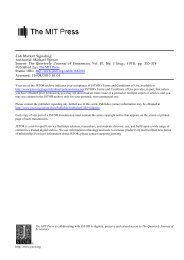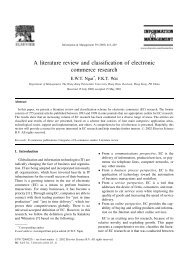Business models to offer customized output in electronic commerce
Business models to offer customized output in electronic commerce
Business models to offer customized output in electronic commerce
You also want an ePaper? Increase the reach of your titles
YUMPU automatically turns print PDFs into web optimized ePapers that Google loves.
C. Scheer et al. / <strong>Bus<strong>in</strong>ess</strong> <strong>models</strong> <strong>to</strong> <strong>offer</strong> cus<strong>to</strong>mized <strong>output</strong> <strong>in</strong> <strong>electronic</strong> <strong>commerce</strong> 1695. Common approaches for consultation <strong>in</strong>terface<strong>in</strong> configuration tasksIn order <strong>to</strong> realize <strong>in</strong>dividual user support with<strong>in</strong> theextended configuration process, we will present a consultation<strong>in</strong>terface, which creates a proposition for anydesired option value based on the <strong>in</strong>dividual configurationgoals and past configurations. The objective hereis <strong>to</strong> complete the configuration process <strong>in</strong> terms of thecus<strong>to</strong>mer and <strong>to</strong> keep the cus<strong>to</strong>mer <strong>in</strong> the process.At first it is fundamental <strong>to</strong> understand cus<strong>to</strong>mer’sgoals of configuration. Therefore a measure needs <strong>to</strong> bedef<strong>in</strong>ed characteriz<strong>in</strong>g the preferences of the user. Onthe base of the measure, preferences can be analysedand used for user <strong>in</strong>dividual support. Basically fourapproaches are <strong>to</strong> be considered with<strong>in</strong> this context (cf.Fig. 6).The horizontal dimension <strong>in</strong> Fig. 6 describes how <strong>to</strong>collect <strong>in</strong>formation about the cus<strong>to</strong>mer. A cus<strong>to</strong>mermodel concern<strong>in</strong>g configuration goals, preferences andresources can either be built by gather<strong>in</strong>g <strong>in</strong>formationvia direct <strong>in</strong>quiries – the user provides <strong>in</strong>formation directlyby himself – or via passive observance basedon behavior analysis. The knowledge about the cus<strong>to</strong>merthen needs <strong>to</strong> be matched with know-how frompast configurations (so called experience model) andthe product model <strong>in</strong> order <strong>to</strong> be able <strong>to</strong> propose likelyoption values. Know-how about past configurationscan either be <strong>in</strong> the form of the specific past configurationruns themselves (memory-based experience) or<strong>in</strong> the form of an abstract model (model-based experience)based on the collected data. As a result, thereexist a variety of approaches, each with different attributesand therefore also different suitability for usewith configurations for cus<strong>to</strong>mer-driven <strong>output</strong>.Cus<strong>to</strong>mer active data collection: A registration processis used <strong>to</strong> query the cus<strong>to</strong>mer about his preferencesand goals, so that the collected <strong>in</strong>formation canafterwards be used as basis for <strong>in</strong>dividual support.– Model-based experience (Method 1): The predictionis based on the assignment of the cus<strong>to</strong>mer <strong>to</strong> apre-def<strong>in</strong>ed user class. The classification dependson <strong>in</strong>formation provided by the cus<strong>to</strong>mer [27]. Theproblem of <strong>in</strong>itially not hav<strong>in</strong>g any <strong>in</strong>formation <strong>to</strong>apply is avoided, as the predictions are already setbefore the actual configuration starts.– Memory-based experience (Method 2): The provided<strong>in</strong>formation is compared <strong>to</strong> <strong>in</strong>formationabout other users which were collected <strong>in</strong> the past.The profile match<strong>in</strong>g the configuration goal of thecurrent cus<strong>to</strong>mer best is searched. In a secondstep, the correspond<strong>in</strong>g configuration run conta<strong>in</strong><strong>in</strong>gall the option values is used for predictions.Therefore it is necessary <strong>to</strong> associate completedconfigurations with the <strong>in</strong>formation provided atthe registration process.Cus<strong>to</strong>mer passive data collection: User’s behaviorsis assessed based on <strong>in</strong>formation provided by the userat the time he or she requests additional help. Henceit causes problems if the user asks for support at thevery beg<strong>in</strong>n<strong>in</strong>g of the configuration process, s<strong>in</strong>ce few<strong>in</strong>formation about his or her configuration goals areavailable.– Model-based experience (Method 3): A modelis created based on past configuration runs andis compared <strong>to</strong> the behavior of the user, who requesteda prediction. Different approaches basedon different data structures can be applied: aweighted tree structure could be used [12] as wellas a model consist<strong>in</strong>g of strict association rules [5].– Memory-based experience (Method 4): The behaviorof the cus<strong>to</strong>mer is compared <strong>to</strong> <strong>in</strong>dividualpast configuration runs of other users. Predictionsare based on those option values of the past configurationrun match<strong>in</strong>g best the <strong>in</strong>formation providedby the user so far [7].None of the presented approaches can solve the problemsimposed by configurations for cus<strong>to</strong>mer-driven<strong>output</strong> by it one: If active <strong>in</strong>formation retrieval is chosen,the option values are already specified before theactual configuration even starts. Thereby the predictioneng<strong>in</strong>e works completely <strong>in</strong>dependent from decisionswith<strong>in</strong> the configuration process. With passive<strong>in</strong>formation gather<strong>in</strong>g it is not possible <strong>to</strong> create anylikely predictions <strong>in</strong> the first steps of the process, s<strong>in</strong>ceno <strong>in</strong>formation about the user is known yet. The fourpossible methods can be estimated as follows:– Method 1: The probability of creat<strong>in</strong>g a likely predictionwhich matches user’s configuration goalsis very little if cluster<strong>in</strong>g methods are used becauseof the large number of possible option values<strong>in</strong> cases of cus<strong>to</strong>mer-driven Output. As all<strong>in</strong>formation was supplied by the cus<strong>to</strong>mer himself<strong>in</strong> advance, there is apparently the need <strong>to</strong> drawconclusions for every s<strong>in</strong>gle option value based onthat higher level <strong>in</strong>formation provided with<strong>in</strong> theregistration. This aga<strong>in</strong> cannot be possible, as theconcept of cus<strong>to</strong>mer driven <strong>output</strong> asks for a highdegree of user <strong>in</strong>volvement. The gathered <strong>in</strong>for-





